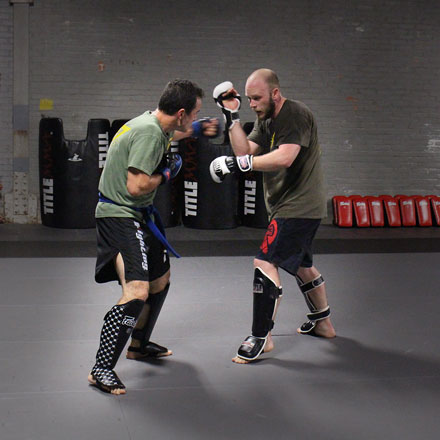Krav Maga Training Methods

Training Method Articles
- Training With Different Partners
- Training In Different Environments
- Being The Athlete/Person You Want To Be
- Beyond Technique
- Habituation
- The Right Balance of Training
- Honesty In Training
- The Place Of Non-Compliance In Training
- CQB/CQC Training
- Being Tough - CQC Training
- Drilling
- Starting 2013 On The Right Footing
- New Year's Resolutions
- Lessons From Close Protection Training
- Environmental Training - Beach Training
- Sparring Training
- Visualization
- Gradings & Lifting Weights
- Training With Heroes
- Training Partners
- Multi-Dimensional Training
- Never Stop Learning
- Testing Your Models of Violence
- Training for Reality - Putting the Pieces Together
- Always Room For Improvement
- Failing & Failure
- Specificity
- Rushing It
- Heavy Bag Workouts
- Working Under Pressure
- Why Scenario Based Training Is Essential For Krav Maga
- Training Vs Reality
- Training Methods That Can Mislead
- Training To Improvise
- Multi-Phase & Multi-Dimensional Training
- Training With Partners
- Drills and Skills
- Experiential Learning: Education Versus Instruction
- Skills and Attributes
- Multi-Dimensional Training Partners
- Skills And Feedback
- Context Appropriate Training
- Understanding & Setting Goals
- Training Components
- Institutionalization versus Individualism
- Solo Training
- Training While Aging
- One Size Doesn't Fit All
- Training Outside Your Comfort Zone
- Breaking Through A Plateau
- Play
- Street Robberies From A Research Based Perspective
- Rules And Discipline In Training
- Solutions Not Techniques
- The Myth of the Krav Maga Stress Test
All Krav Maga Articles
Krav Maga's Training Methods
Krav Maga has developed some unique training methods to develop various fighting skills in non-injurious ways. A significant characteristic of Krav Maga’s training methods is “safety in training” i.e., if you are injured whilst training and as a result are unable to defend yourself in reality, your training has failed you. Below are descriptions and explanations of some of the different types of Krav Maga training that characterize its approach to self-defense and fighting.
Krav Maga Training Methods - Fighting Games
Whilst sparring has an important place in Krav Maga training, there is obviously the potential risk of injury and/or concussion etc. “Fighting Games” aim to train and develop fighting skills, in a safer way, whilst still capturing the dynamic and “open” nature of sparring (in Krav Maga drills as categorized as either “Closed” or “Open”: Closed Drills being those where there are defined and predictable outcomes, and Open Drills, which have unpredictable outcomes, such as sparring etc.). Fighting Games are a more collaborative type of training than sparring, where participants keep the same speed as when sparring but reduce the power of the strikes i.e., strikes are delivered light and fast etc. Fighting Games are also more collaborative, with training partners allowing each other to perform techniques fully and cleanly. Pressure is increased up until the point where form goes, and then reduced. In the Krav Maga Yashir system this form of training is normally used as the warm-up, as opposed to traditional martial arts warm-ups, which comprise running, pushups, and sit-ups etc. The reason for this is to devote as much class time to develop fighting skills, such as effective movement, control of range, and positioning etc., as opposed to performing calisthenics, which a practitioner can practice on their own etc.
Krav Maga Training Methods - Slow-Fighting
When sparring was first introduced to Krav Maga training it was quickly discovered that participants stepped back from one another and gave each other the luxury of controlling range. Something which is natural when you want to avoid being punched and kicked etc. The issue with this is that most real-life confrontations happen at extremely close range, where combatants are usually nose-to-nose etc. Whilst recognizing the importance of sparring, but also being aware of the parts and dimensions of a fight, which it doesn’t easily replicate, “Slow Fighting” was developed. This is a non-injurious way to develop close-range fighting skills, at a distance where tools such as knee, elbow strikes, and head butts become the primary weapons. By moving in close and slowing down the speed of these strikes it is possible to practice close range fighting without the danger of getting hurt or injured.
Krav Maga Training Methods - Stress-Testing
A fight can have multiple dimensions e.g., it can start off with participants kicking and punching, then moving to grappling, where one pulls a knife, and then both combatants end up on the ground etc. Stress-Testing aims to break these dimensions down into distinct parts but join them up, so they are experienced as a continuous chain e.g., a student faces a group, who make and perform different singular attacks and threats against them with no gap in between. This could see on member of the group perform a gun-threat, and as soon as a disarm has been performed, another member attacks them with a training knife etc. Part of the goal of such training is to develop threat-recognition and decision-making skills by giving the participant being stress-tested little to no time to think about their response and instead just react to whatever is happening to them.
These three methods of Krav Maga training, are not exhaustive but they give an idea as to how Krav Maga training is designed to be controlled, safe and non-injurious.